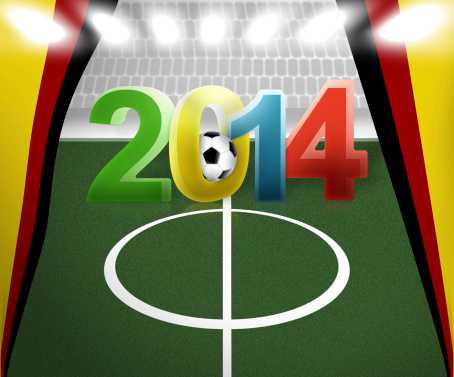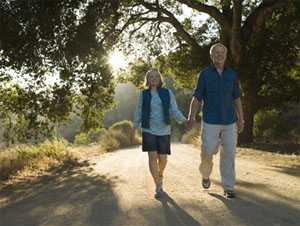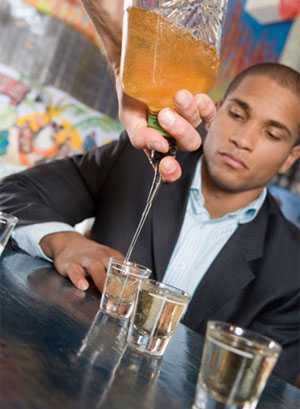Have You Heard? 2014

Learn About Thyroid Disease and Raise Awareness
Monday, January 27, 2014
The thyroid gland, located in the front of the neck just below the Adam’s apple, takes iodine from the diet and makes thyroid hormone. Thyroid hormone affects a person’s physical energy, temperature, weight and mood. Thyroid diseases generally fall into two broad groups of disorders: abnormal function and abnormal growth (nodules) in the gland. These problems are common in the general population, especially among older people and women. Most thyroid problems can be detected and treated.

Protect Your Eyes During National Glaucoma Awareness Month
Tuesday, January 21, 2014
Glaucoma is a group of diseases that can damage the eye’s optic nerve and can result in vision loss and blindness. Glaucoma occurs when the normal fluid pressure inside the eyes slowly rises. However, recent findings now show that glaucoma can occur with normal eye pressure. With early treatment, you can often protect your eyes against serious vision loss.

January is Cervical Health Awareness Month
Monday, January 13, 2014
All women are at risk for cervical cancer. It occurs most often in women over age 30. Each year, about 12,000 women in the United States get cervical cancer. Cervical cancer is highly preventable in most Western countries because screening tests and a vaccine to prevent HPV infections are available.

What You Should Know for the 2013-2014 Influenza
Monday, January 6, 2014
Flu seasons are unpredictable in a number of ways. Although epidemics of flu happen every year, the timing, severity, and length of the season varies from one year to another. CDC recommends a yearly flu vaccine for everyone 6 months of age and older as the first and most important step in protecting against this serious disease.

Five Facts about Congenital Heart Defects
Monday, February 24, 2014
Congenital heart defects are conditions present at birth that affect how a baby’s heart is made and the way it works. They are the most common type of birth defects. In the United States, about 40,000 infants are born with a heart defect each year.

Brush Up on Healthy Teeth
Tuesday, February 18, 2014
Every parent knows that a healthy smile is a sign of a happy child, and oral health experts agree that creating those healthy smiles begins in infancy. CDC experts have developed a set of pediatric oral health tips.

Dating Matters™: Strategies to Promote Healthy Teen Relationships
Monday, February 10, 2014
Heart disease is a major problem. Every year, about 715,000 Americans have a heart attack. About 600,000 people die from heart disease in the United States each year—that’s 1 out of every 4 deaths. Heart disease is the leading cause of death for both men and women. Every journey begins with one step, whether it’s climbing a mountain or preventing heart disease. This American Heart Month, CDC is offering tips for better heart health. Take your first step on the road to a healthy heart with us.

February is American Heart Month
Monday, February 3, 2014
Heart disease is a major problem. Every year, about 715,000 Americans have a heart attack. About 600,000 people die from heart disease in the United States each year—that’s 1 out of every 4 deaths. Heart disease is the leading cause of death for both men and women. Every journey begins with one step, whether it’s climbing a mountain or preventing heart disease. This American Heart Month, CDC is offering tips for better heart health. Take your first step on the road to a healthy heart with us.

Worker Safety after a Flood
Monday, March 31, 2014
The danger of a flood does not end when the rains cease. Cleanup crews must work together and look out for one another to ensure safety. For most work in flooded areas, workers will need hard hats, goggles, heavy work gloves, and watertight boots with steel toe and insole (not just steel shank).

CDC Resources for National Nutrition Month
Monday, March 24, 2014
It’s no secret that good nutrition plays an essential role in maintaining health. While you already know it is important to eat a healthy diet, you may find it more difficult to sort through all of the information about nutrition and food choices. CDC has compiled a variety of resources to help you start healthier eating habits.

World TB Day 2014
Monday, March 17, 2014
World TB Day provides the opportunity to raise awareness about TB-related problems and solutions and to support worldwide TB-control efforts. While great strides have been made to control and cure TB, people still get sick and die from this disease in our country. Much more needs to be done to eliminate this disease.

Learn about TBI during Brain Awareness Week
Monday, March 10, 2014
Traumatic brain injury (TBI) is a serious public health problem in the United States. Each year, traumatic brain injuries contribute to a substantial number of deaths and cases of permanent disability. Every year, at least 1.7 million TBIs occur either as an isolated injury or along with other injuries.

Patient Safety Awareness Week: Ten Things You Can Do to Be a Safe Patient
Monday, March 3, 2014
You go to the hospital to get well, right? Of course, but did you know that patients can get infections in the hospital while they are being treated for something else? Here are ten things you can do to be a safe patient.

Managing Stress
Monday, April 28, 2014
Stress can hit you when you least expect it—before a test, after an accident, or during conflict in a relationship. While everyone experiences stress at times, a prolonged bout of it can affect your health and ability to cope with life. That’s why social support and self-care are important. They can help you see your problems in perspective…and the stressful feelings ease up. Find out how to manage stress by following CDC’s recommended tips for self-care.

Prevent Child Maltreatment
Monday, April 21, 2014
Child Maltreatment (CM) is a significant public health problem in the United States. According to Child Protective Service agencies, more than 676,000 children were found to be victims of maltreatment in 2011. Another 1,545 children died from violence that same year. Abused children often suffer physical injuries including cuts, bruises, burns, and broken bones. Physical injury is far from the only negative impact of maltreatment—it can also affect broader health outcomes, mental health, social development, and risk-taking behavior into adolescence and adulthood.

CDC provides health and safety tips for travelers to 2014 World Cup in Brazil
Wednesday, April 16, 2014
Every four years, millions of people from around the globe gather for the World Cup, the popular professional soccer tournament. For Americans who plan to attend this year’s World Cup, CDC is providing recommendations to stay healthy and safe.

What Is Skin Cancer?
Monday, April 14, 2014
Skin cancer is the most common form of cancer in the United States. The two most common types of skin cancer—basal cell and squamous cell carcinomas—are highly curable, but can be disfiguring and costly. Melanoma, the third most common skin cancer, is more dangerous and causes the most deaths. The majority of these three types of skin cancer are caused by exposure to ultraviolet (UV) light.

CDC Recommendations for Influenza Antiviral Medications Remain Unchanged
Thursday, April 10, 2014
CDC continues to recommend the use of the neuraminidase inhibitor antiviral drugs (oral oseltamivir and inhaled zanamivir) as an important adjunct to influenza vaccination in the treatment of influenza. CDC’s current influenza antiviral recommendations are available on the CDC website and are based on all available data, including the most recent Cochrane report, about the benefits of antiviral drugs in treating influenza.

Five Minutes or Less for Health Weekly Tip: Teach Kids Healthy Habits
Monday, April 7, 2014
Healthy kids are more likely to become healthy adults. Be a role model and help your kids develop skills to make safe and healthy choices every day.

New CDC.gov Homepage Released
Thursday, May 8, 2014
Public health professionals, healthcare providers and the general public can now experience an optimized homepage from the Centers for Disease Control and Prevention (CDC) at CDC.gov. The new CDC.gov design is “responsive,” automatically optimizing its design and features uniquely for users’ phone, tablet, laptop, or widescreen. Perhaps best of all, users to the website can enjoy this experience however they access CDC digitally. Visitors will see this approach appearing across the entire CDC website as more and more of our pages are moved into this new template.

Diabetes Resources for Asian Americans, Native Hawaiians, and Pacific Islanders
Monday, June 30, 2014
This downloadable catalog organizes the National Diabetes Education Program’s Asian Americans, Native Hawaiians, and Pacific Islanders resources in three main categories. Each of these categories includes culturally and linguistically tailored resources that respond to the unique needs of Asian Americans, Native Hawaiians, and Pacific Islanders. You’ll also find quick reference information that lets you know at a glance what materials are available in languages other than English and are culturally relevant for specific communities. Resources can be downloaded by clicking on the title of the resource. You will need the free Acrobat Reader to read some of the resources.

Arthritis Pain Reliever
Monday, June 23, 2014
Long gone are the days when health care providers told people with arthritis to “rest their joints.” In fact, physical activity can reduce pain and improve function, mobility, mood, and quality of life for most adults with many types of arthritis, including osteoarthritis, rheumatoid arthritis, fibromyalgia, and lupus. Physical activity can also help people with arthritis manage other chronic conditions such as diabetes, heart disease, and obesity. Most people with arthritis can safely participate in a self-directed physical activity program or join one of many programs available in communities across the country. Some people may benefit from physical or occupational therapy. A sheet summarizing physical activity for people with arthritis is available.

Chronic Disease at Work
Monday, June 16, 2014
Chronic diseases such as depression and hypertension can lead to a decline in the overall health of employees in a workplace, contribute to an increase in health-related expenses for employers and employees, and lead to days away from work. Many businesses have realized the benefits of health promotion, and to curb the costs of rising health care they have begun offering wellness programs to their employees. Ideally, the office should be a place that not only protects the safety and well-being of employees but also provides them opportunities for better long-term health.

Vision Health Initiative
Monday, June 9, 2014
Approximately, 11 million Americans aged 12 years and older could improve their vision through proper refractive correction. More than 3.3 million Americans aged 40 years and older are either legally blind (having best-corrected visual acuity of 6/60 or worse (=20/200) in the better-seeing eye) or are with low vision (having best-corrected visual acuity less than 6/12 (<20/40) in the better-seeing eye, excluding those who were categorized as being blind). The leading causes of blindness and low vision in the United States are primarily age-related eye diseases such as age-related macular degeneration, cataract, diabetic retinopathy, and glaucoma. Other common eye disorders include amblyopia and strabismus.

Promoting Clean Healthy Water
Monday, June 2, 2014
Improvements in water quality have dramatically improved the public’s health in the United States. However, some old challenges remain, and new ones are emerging. For some communities, access to plentiful healthy water is, or may soon be, limited by the presence of environmental pollutants in local water sources, drought and groundwater depletion that limits water availability, flooding events that overwhelm local treatment capacity, local weather changes associated with climate change, new and more stringent regulations, or failures in water-related infrastructure. CDC’s Health Studies Branch has an urgent mission to work with public health partners to protect public health by assessing and mitigating waterborne exposures and related disease.

Prevent 269 Fall Fatalities and Stand-Down
Monday, July 28, 2014
More construction workers die from falls than from any other on-the-job injury, according to data from the U.S. Bureau of Labor Statistic. The construction falls prevention campaign is a collaborative effort out of the National Occupational Research Agenda (NORA) program, which brings together partners from government, labor, management, and academia. The primary goal of the campaign is to raise awareness and equip contractors and workers with information to help them prevent falls.

Traumatic Brain Injury
Monday, July 21, 2014
Traumatic brain injury (TBI) is a serious public health problem in the United States. Each year, traumatic brain injuries contribute to a substantial number of deaths and cases of permanent disability. A TBI is caused by a bump, blow or jolt to the head or a penetrating head injury that disrupts the normal function of the brain. CDC’s research and programs work to prevent TBI and help people better recognize, respond, and recover if a TBI occurs.

Measles: Make Sure You and Your Family Are Fully Vaccinated
Monday, July 14, 2014
Measles is a highly contagious respiratory disease caused by the measles virus. The disease is also called rubeola. Measles causes fever, runny nose, cough and a rash all over the body. About one out of 10 children with measles also gets an ear infection, and up to one out of 20 gets pneumonia. For every 1,000 children who get measles, one or two will die. Adults can also get measles, especially if they are not vaccinated. Make sure you and your family are update on measles-mumps-rubella (MMR) vaccine, including before leaving for trips to other countries.

Your Preteens and Teens Need Vaccines Too!
Monday, July 7, 2014
While your preteens and teens are thinking about all the fun things they’ll be doing this summer, you’re probably thinking about keeping them healthy and safe. When you’re planning trips to get new swimsuits and sunscreen, make an appointment for vaccinations before the back-to-school rush begins at the doctor’s office. Vaccines can help our kids stay healthy, and most states require certain vaccinations before school starts again in the fall.

Tips for Calming Your Crying Baby
Monday, August 25, 2014
All babies cry and at times it can leave parents feelings helpless and frustrated. Understanding why a baby cries can help parents feel more confident in responding to their baby’s needs.

What are the Reasons to Vaccinate My Baby?
Monday, August 18, 2014
There’s no greater joy than helping your baby grow up healthy and happy. That’s why most parents choose immunization. Giving your baby the recommended immunizations by age two is the best way to protect him from 14 serious diseases, like measles and whooping cough.

Depression Among Women of Reproductive Age
Monday, August 11, 2014
Many women experience depression including pregnant women, postpartum women, and women who are not pregnant. Depression has symptoms, just like other illnesses. You may have heard of postpartum depression (PPD), but many women don’t know that depression can occur during pregnancy or with other events, such as losing a baby or having trouble getting pregnant.

Child Passenger Safety: Fact Sheet
Monday, August 4, 2014
Motor vehicle injuries are a leading cause of death among children in the United States. But many of these deaths can be prevented. Buckling children in age- and size-appropriate car seats, booster seats, and seat belts reduces serious and fatal injuries by more than half.

Get the Facts about Ovarian Cancer
Monday, September 29, 2014
Cancer is a disease in which cells in the body grow out of control. Cancer is always named for the part of the body where it starts, even if it spreads to other body parts later. When cancer starts in the ovaries, it is called ovarian cancer. Women have two ovaries that are located in the pelvis, one on each side of the uterus. The ovaries make female hormones and produce eggs. When ovarian cancer is found in its early stages, treatment is most effective.

Traumatic Brain Injury
Monday, September 22, 2014
Traumatic brain injury (TBI) is a major cause of death and disability in the United States, contributing to about 30% of all injury deaths. Every day, 138 people in the United States die from injuries that include TBI. Those who survive a TBI can face effects lasting a few days to disabilities which may last the rest of their lives. Effects of TBI can include impaired thinking or memory, movement, sensation (e.g., vision or hearing), or emotional functioning (e.g., personality changes, depression). These issues not only affect individuals but can have lasting effects on families and communities.

Family Health and Fitness
Monday, September 15, 2014
Regular physical activity can improve your overall health and fitness, and reduce your risk for many chronic diseases. Find out what you and your family can do to be active.

Fruit and Veggies
Monday, September 8, 2014
Eat your fruits and vegetables.” You’ve likely heard this statement since childhood. Research shows why it is good advice.

Youth Alcohol Abuse
Monday, October 27, 2014
Alcohol and other drug use among our nation’s youth remains a major public health problem. Substance use and abuse can increase the risk for injuries, violence, HIV infection, and other diseases.

Preventing the Flu: Good Health Habits Can Help Stop Germs
Monday, October 20, 2014
The single best way to prevent seasonal flu is to get vaccinated each year. Additionally, good health habits like covering your cough and washing your hands often can help stop the spread of germs and prevent respiratory illnesses like the flu. There also are flu antiviral drugs that can be used to treat and prevent the flu.

Depression in the Workplace
Monday, October 13, 2014
The mental health of workers is an area of increasing concern to organizations. Depression is a major cause of disability, absenteeism and productivity loss among working-age adults. The ability to identify major depression in the workplace is complicated by a number of issues such as employees’ concerns about confidentiality or the impact it may have on their job that cause some people to avoid screening.

Dangers of Teenage Driving
Monday, October 6, 2014
Motor vehicle crashes are the leading cause of death among teenagers. In 2011, about 2,650 teens in the United States ages 16 to 19 were killed and almost 292,000 were treated in emergency departments for injuries suffered in motor-vehicle crashes. This means about seven teens, ages 16 to 19, died every day from motor vehicle injuries that year. Per mile driven, teen drivers ages 16 to 19 are three times more likely than drivers aged 20 and older to be in a fatal crash.

Causes of Alzheimer’s Disease
Monday, November 24, 2014
Scientists do not yet fully understand what causes Alzheimer’s disease. There probably is not one single cause, but several factors that affect each person differently.

Drowsy Driving
Monday, November 17, 2014
Falling asleep at the wheel is clearly dangerous, but being sleepy affects your ability to drive safely even if you don’t fall asleep. Although it may be difficult to attribute a fatal vehicle crash to drowsy driving, the National Highway Traffic Safety Administration estimates that 2.5 percent of fatal crashes and 2 percent of injury crashes involve drowsy driving.

What Is COPD?
Monday, November 10, 2014
Chronic Obstructive Pulmonary Disease, or COPD, refers to a group of diseases that cause airflow blockage and breathing-related problems. It includes emphysema, chronic bronchitis, and in some cases asthma.

Diabetic Retinopathy
Monday, November 3, 2014
Diabetic retinopathy (DR) is a common complication of diabetes. It is the leading cause of blindness in American adults. It is characterized by progressive damage to the blood vessels of the retina, the light-sensitive tissue at the back of the eye that is necessary for good vision.

Salmonella is a Sneaky Germ: Tips for Safer Eating
Monday, December 22, 2014
Salmonella is a bacteria and a common cause of foodborne illness, sometimes called “food poisoning.” In the past few years, large outbreaks of illness cau sed by Salmonella-contaminated eggs and peanut products have made the headlines. Although many other foodborne illnesses have declined in the past 15 years, Salmonella infections have not declined at all.

Alcohol Deaths
Monday, December 15, 2014
Excessive alcohol use is a leading cause of preventable death. This dangerous behavior accounted for approximately 88,000 deaths per year from 2006–2010, and accounted for 1 in 10 deaths among working-age adults aged 20–64 years. Excessive alcohol use shortened the lives of those who died by about 30 years. These deaths were due to health effects from drinking too much over time, such as breast cancer, liver disease, and heart disease, and health effects from consuming a large amount of alcohol in a short period of time, such as violence, alcohol poisoning, and motor vehicle crashes.

Diagnosing Flu
Monday, December 8, 2014
Your respiratory illness might be the flu if you have fever, cough, sore throat, runny or stuffy nose, body aches, headache, chills and fatigue. Some people may have vomiting and diarrhea. People may be infected with the flu and have respiratory symptoms without a fever. Flu viruses usually cause the most illness during the colder months of the year. However, influenza can also occur outside of the typical flu season. In addition, other viruses can also cause respiratory illness similar to the flu. So, it is impossible to tell for sure if you have the flu based on symptoms alone.

Eliminating HIV Infections in Children and Keeping their Mothers Alive
Monday, December 1, 2014
The transmission of HIV from mothers to their infants contributes substantially to global morbidity and mortality for children under-5 years of age. Approximately 1000 HIV-infected infants are born every day, mostly in sub-Saharan Africa, amounting to nearly 370,000 new pediatric infections annually. Without treatment, over half of these children will die before the age of two Fortunately, prevention of mother-to-child HIV transmission can be accomplished by effective, accessible, and scalable interventions within existing maternal and child health services.
- Page last reviewed: March 3, 2014
- Page last updated: March 3, 2014
- Content source:



 ShareCompartir
ShareCompartir